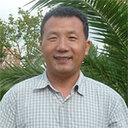Biomimetic nanoassemblies of 1-O-octodecyl-2-conjugated linoleoyl-sn-glycero-3-phosphatidyl gemcitabine with phospholipase A2-triggered degradation for the treatment of cancer.
Słowa kluczowe
Abstrakcyjny
Phospholipids are important biomolecules with strong self-assembling ability to form biomembranes or liposomes. However, biomimetic prodrugs of phospholipids are not well known, including their self-assembling behavior at the air/water interface or in aqueous media. Here we design and prepare a biomimetic phospholipid-like amphiphilic prodrug, 1-O-octodecyl-2-conjugated linoleoyl-sn-glycero-3-phosphatidyl gemcitabine (OLGPG). After spreading at the air/water interface, it formed Langmuir monolayers. Stable nanoassemblies were obtained based on molecular self-assembly after OLGPG was injected in water. An amphiphilic long-chained lipid, cholesteryl hemisuccinate polyethylene glycol 1500 (CHS-PEG) was mixed in the OLGPG Langmuir monolayers and nanoassemblies with the optimal proportion. The OLGPG and OLGPG/CHS-PEG nanoassemblies were spherical vesicles due to the hydrophobic interaction of lipid moieties with the small sizes of 50.33nm and 64.76nm, respectively. Phospholipase A2 (PLA2) is highly expressed in tumor tissues to specifically degrade the 2-acyl of phospholipid to lysophospholipid. OLGPG showed PLA2-sensitive degradation. The nanoassemblies showed higher in vitro anticancer effect on HepG2 cells than the parent drug gemcitabine. In the in vivo studies on the hepatocellular tumor-bearing mouse model, the OLGPG/CHS-PEG nanoassemblies group (eq. to 1/5 dose of the Gem group) showed the highest antitumor and tumor targeting effects compared to the other groups. The long-circulating phospholipid-like prodrug nanoassemblies are the promising anticancer nanomedicines based on the biomimetic strategy and specific tumor microenvironment.


